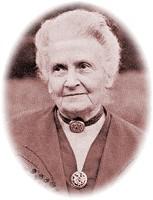 Dr. Maria Montessori
Dr. Maria Montessori
Dr. Maria Montessori was a woman ahead of her time. She became Italy’s first female doctor when she graduated cum laude from the University of Rome in 1896. In her medical practice, Dr. Montessori became extremely interested in how children learn – and her clinical observations led her to conclude that children teach themselves as they interact with their environment. To further explore and understand this concept, she returned to the university, this time to focus more on the matters of the mind, concentrating her studies in the areas of psychology and philosophy. In 1904, she became professor of anthropology at the University of Rome. In 1907, she left both her medical practice and her promising university career to pursue her dream: implementing a new system of education that was respectful of children and which allowed them to learn at their own pace. She was subsequently asked to teach sixty children in the slums of Rome, many of whom were thought to be un-teachable. By observing these children, she developed the Montessori Method of development from birth to adulthood.
Dr. Montessori’s success with these “un-teachable” children proved the impossible possible, and the rest is history. Today, more than one hundred years after the first Montessori school was formed, Dr. Montessori’s legacy is still touching the lives of children and their families all over the world.
Montessori Philosophy
The Montessori philosophy is based on a deep respect for each child’s individuality, abilities, and fundamental needs. From birth, children are seen as capable and as their own teacher. Maria Montessori observed that children teach themselves through interacting with their environment and that that there is a perfect window of opportunity for learning certain skills or concepts. By introducing these skills at the optimal time, adults can help make the most of children’s natural development.
Dr. Montessori also noticed that during the first six years of life, children absorb everything they see and hear, for they have an “absorbent mind” which allows them to adapt to their time, place and culture. Neuroscience has since validated her observational discoveries: the plasticity of the brain in early years, the importance of early experiences on brain development, and the existence of windows of opportunity (or critical periods) for acquiring specific developmental aptitudes such as walking or talking.
Montessori Method
The ultimate aim of the Montessori Method is to release the potential of each human being. The word “release” echoes with the original meaning of the word education, which is “to lead out” or “to bring forth.”
What makes Montessori education so successful is its unique practical approach to nurturing the natural development of each individual. The Montessori Method is based on three components: the child, the adult and the prepared environment.
Dr. Montessori understood that all children are in a process of self-formation and pass through the same basic stages to reach adulthood. Children are intrinsically motivated to develop and create themselves through meaningful experiences in a loving and nurturing environment. Yet, she also emphasized that each child is different and must be regarded as a unique being. So Montessori education is individualized: each child is allowed to progress at his or her own pace.
Within this construct, the adult serves as an astute observer and record-keeper who is knowledgeable about the principles of child-development. Montessori education is child-centered in the belief that learning necessarily follows the child’s interests rather than the adult’s preset timetable – the latter of which is unfortunately customary in traditional education. In the Montessori method, the adult facilitates the child’s learning through loving guidance and by designing and “preparing” a nurturing environment.
Since children learn through experiences, it is vital to create an environment suited for their optimal growth, thus the environment is said to be “prepared.” Such an environment answers the children’s needs for love, consistency, order, independence and safety.
Benefits of the Montessori Method
- The Montessori Method helps children become happy human beings who are independent thinkers and life-long learners.
- It encourages self-discipline, self-knowledge, academic skills, problem-solving ability and an enthusiasm for learning.
